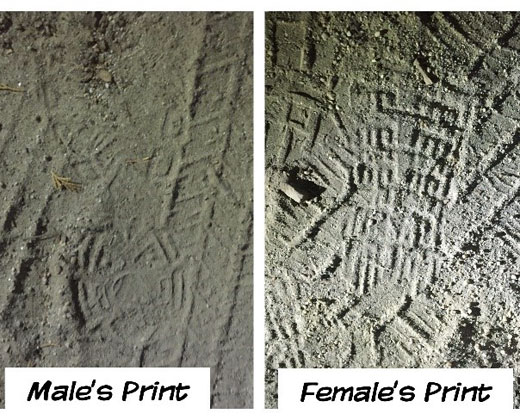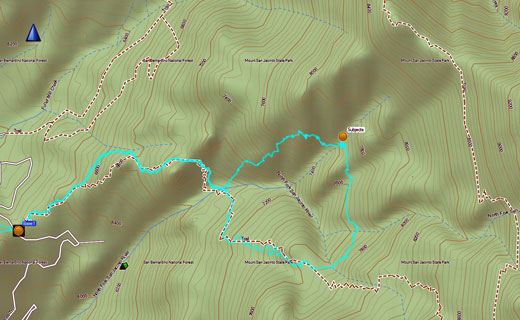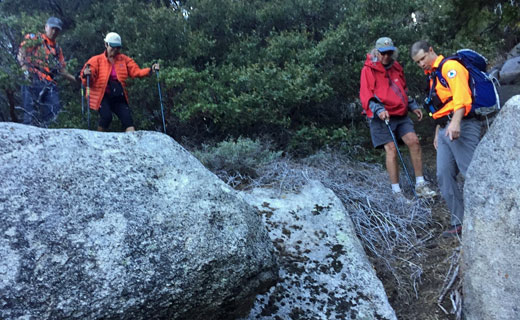Rescue Lost Seniors Near Seven Pines Trail
|
August 14, 2016 |
Written by Kevin Kearn
On Sunday evening, after the entire team had finished working our Annual Pancake Breakfast Fundraising Event in Idyllwild that morning, the Riverside Sheriff’s Office (RSO) alerted RMRU at 8:45Ppm to rescue two lost seniors east of the Seven Pines Trail. The subjects were a 67-year-old female and 70-year-old male. The husband and wife of 50 years had contacted RSO late in the afternoon after wandering off the Seven Pines Trail before their cellphone became too depleted to use.
RSO was able to dispatch Star-9(helicopter) and, in early evening, located the couple’s position just east of the Seven Pines Trail. They were somewhat trapped in a very steep drainage. Star-9 was able to hover over the trees near their position and use their loudspeaker to tell the couple that help would be on the way and to remain in place.
RMRU received the call later and by 9pm, Cameron, Dana, and I were responding. By the time Dana and Cameron picked up the RMRU truck from the Hemet Sheriff’s sub-station, met me, and drove over backroads to the Seven Pines Trailhead, it was 11:30pm. We met with Deputy Jensen and issued him a radio while he maintained his position at the parking lot serving as our Base (Command Post). We carefully inspected the area around our subject’s car and were able to determine and photograph, both the wife’s and husband’s unique footprint patterns. It was important to have these print patterns in case our subjects had moved and we needed to locate and pursue their tracks to find them. We were fortunate in that the area around the car had not been contaminated with other tracks.

Subjects Foot Prints
Photo by Kevin Kearn.
We plotted our subjects’ location on our maps and uploaded coordinates into our GPS’s. Star-9’s coordinates put our couple high in a drainage/draw at almost 7,700’, at least three draws north and over ½ mile from the trail. We decided the best course of action was to take the Seven Pines Trail up to the intersection of the drainage at 6,900’ and attempt to ascend up to their location from the there. If the couple had panicked and moved, they would likely have attempted to descend the drainage. By travelling up the drainage, we had a better chance of closing in on them in case they did displace.

Rescue Teams Route Up and Down
Photo by Kevin Kearn.
Temperatures had been above average that day, and at midnight, temps were still in near 70 degrees with almost no breeze as we moved up the trail. The moon was out the whole night providing a welcomed 98% illumination. We’d anticipated that our subjects would probably be suffering from dehydration so we carried extra water as well as two spare headlamps. After arriving at the intersection with the drainage and assaulted by relentless waves of mosquitoes, we felt that the drainage itself was too strewn with debris and difficult to move quickly and safely through. We decided to travel up the north wall of the drainage and do our callouts from the edge of the walls down into it as we ascended.
We climbed up over 700’ through thick brush over steep terrain until we were at the same elevation (7,700’) and near the given location. With little wind our voices echoed across the ravine, but despite our strong call-outs, we had no responses. We contacted Deputy Jensen at our Base and he was able to direct Star-9 to return to the area and attempt to locate out subjects. Because of the residual high surface temperatures, it was impossible to leverage their FLIR camera to detect the subjects body heat. After twenty minutes of circling the area with their white spotlight, they were still unable to locate the subjects again. We were concerned that the subjects had moved. Star-9 also confirmed that they were not able to do any hoisting with the crew that night, were low on fuel, and going off station at 0300. It was 0225 hours when they left.
After Star-9’s departure, we moved up to the edge of the drainage again to do a call-out - hoping that they may have awoken if they had been asleep. This time we heard the female subject respond and reported audio contact. It took another 20 minutes to safely descend the north wall of the drainage, cross, and close with the subjects perched higher on the south wall.
Both were in stable condition, cold, and dehydrated. Cameron gave his jacket to the female and I gave mine to the male as well as the headlamps. They were extremely relieved and grateful as they consumed lots of water, warmed up, ate, and put on insect repellent. We made the decision that given the age and condition of the subjects, coupled with the steep and difficult terrain, we would remain in place until dawn when it would be safer to move.
It was actually cool for the three hours we stayed in place. Our subjects had the extra clothing we gave them and both huddled warmly together in a bivy sack we brought. Cameron, Dana, and I, all chillier than we expected to be, slept side by side together under a single emergency reflective Mylar blanket. We probably looked out of place and more like we belonged under a highway bridge.
When we rose at 0600, our subjects reported feeling much better. Our first choice would have been to locate a clearing and try to extract them by air but Star-9 wouldn’t come on station for two more hours and it may have been even more difficult just finding a suitable clearing. We decided we would try to hike south slowly back to the Seven Pines Trail along our current elevation contour.

(L-R) Dana, Woman, Man, and Cameron
Photo by Kevin Kearn.
Movement was extremely slow. I navigated and reconnoitered the easiest path while Cam escorted the male and Dana trailed escorting the female. Both subjects, somewhat challenged on the steep terrain, had great attitudes and remained in good spirits as we made our way back .75 miles to the trail. By 0730, we were moving down the trail and by 0915 had linked up at Base with RSO.
Lessons Learned:
Without a Light, Sit Tight at Night: Even with a nearly full moon, our subjects could not have moved safely in the rugged terrain without a flashlight. Even if you’re going out for a “day hike” always pack a head lamp in case you are out later than expected. They are small, inexpensive, and can allow you to move at night with lesser risk of injury. If you find yourself in treacherous terrain unable to see without a sufficient light, try to shelter and remain in place until it’s light again.
When Lost, Stay Put, and Don’t Become More Lost: The subjects did the right thing by staying where they were. When spotted by Star-9, they were directed to stay where they were and that help would come. Too often, lost subjects panic when rescuers don’t arrive quickly and become demoralized; this sometimes leads them to conclude that rescuers are not coming and that they must move. This almost always frustrates rescue efforts when precious resources move to the point last seen (PLS) and/or around it only to discover the subjects are not there. It can significantly extend a search when subjects move further away from their PLS.
Always Bring Small Signal Devices (Whistle and Mirror): A whistle carries much further than a human voice and is easier to do especially when one is tired or injured. Whistles can generally be heard over a ½ mile away under good conditions. Visual signal devices are equally important – day or night. A lightweight, commercial 2”x 3” signal mirror is best during the day but a compass mirror can work almost as well. Strobes and Rescue Lasers are great at night but, at a minimum, a chemlight (especially whipped around in a circle on a short cord), flashlight, or signal fire are practical visual signals too. Had the subjects been able to signal Star-9 or our party across the drainage, it would have made the rescue even faster.
RMRU Members Involved: Cameron Dickinson, Kevin Kearn, and Dana Potts.